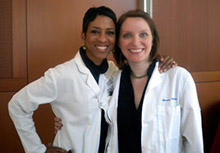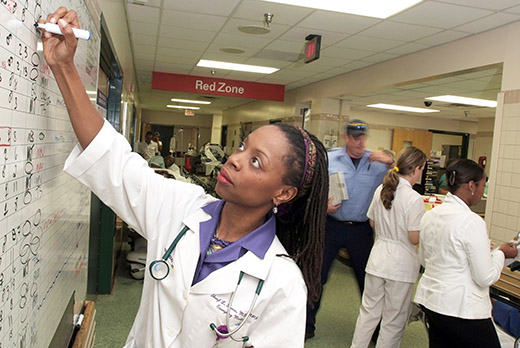Kimberly Manning is a hospitalist at Grady Memorial Hospital in Atlanta, an associate professor of medicine at Emory University School of Medicine, and an adviser in the Semmelweiss Society—one of 16 faculty who work with the same small group of students throughout their time in medical school.
Her interests include humanism in medicine and the use of reflective writing. She practices what she preaches by writing a blog about her experiences at Grady. “I write to share the human aspects of medicine and teaching and work-life balance,” Manning says, “and to honor the public hospital and her patients, but never at the expense of patient privacy or dignity.”
She also writes about her frustrations and ways that she stays energized and optimistic in the face of daunting amounts of human tragedy.
Usually, she copes very well, finding joy in the job on most days. In July 2017, she was having a very rough day, which she described on her blog in an entry titled "Heavy on My Soul":“You okay, doc?
“Who me?” I pointed at my chest.
“Yeah, you.”
I turned my head away from the television and back toward him. I poked out my lip and furrowed my brow.
“Look like you got something heavy on your soul.”
Heavy on my soul. I didn’t say anything. Instead I just stared at him, surprised at how warm my face was becoming and how my eyes were stinging with tears.
“I’m okay,” I finally said, speaking quietly. “But yes. That’s a good way to put it.”
I wanted to tell him. I wanted to tell my patient all about what was weighing me down.
But I was his doctor. So when he asked, I just stayed silent.
As soon as I got out of there, I turned my forehead into the nearest wall and let myself cry.
I could feel the people looking at me as they walked by, their feet slowing down and wondering what could be going on with this doctor and the muffled, guttural sounds she was making. No one said anything.
Maybe my actions spoke enough. I mean, whatever it was had to be awful.
A doctor facing a wall with shoulders shaking and body heaving in a stiff white coat said plenty.

Kim Manning with Alanna Stone at Emory Match Day
Manning first came to know Alanna Stone when Stone was a medical student in her small group of advisees, and was delighted when they ended up working together at Grady. Like many of Stone’s friends and colleagues, Manning rallied around the young doctor when, having overcome breast cancer, Stone developed acute leukemia.
After months of staying hopeful, Manning got the news that Stone had taken a turn for the worse and wasn’t going to make it. Unable to hide her preoccupation from one of her patients, Manning shared the basics of what was happening and left the room before bursting into tears. Crying in the hallway, she admits, “is not in the physician playbook.”
“I was crying because I would miss seeing the life of this beautiful woman continuing to unfold,” Manning wrote in her blog. “I was crying because 34 is too young to die. Crying because a little boy had lost his mother and a husband had lost his wife. Crying because one of the most epic students-turned-doctors that I have ever witnessed has had her career cut short, and because patients like the one I’d just left would never get to meet her. But, also, I was crying because of that moment with that patient, and how Alanna herself understood more than anyone that patients take care of doctors, too. That patients save their doctors’ lives every single day.”
Physician Burnout
Physicians are, of course, human. They experience sadness and fear, illness and loss, anxiety and depression. They get overwhelmed, overloaded, and overextended.
But something has changed. Physician burnout is at an all-time high, with more than half of physicians saying they experience symptoms: emotional exhaustion, a loss of meaning in work, a sense of ineffectiveness, or a lack of engagement with patients. This represents a 25 percent increase over the past four years and cuts across physician gender, age, and ethnicity.
On any given day, 30 percent of physicians say they feel stressed out, and 39 percent feel depressed. Such feelings can be fatal. Every year, about 400 physicians die by suicide. Many of them had not sought treatment or professional help beforehand, telling friends and family they feared it could have a negative impact on their careers.
“The day they start school, medical students actually are happier and better adjusted than their education-comparable peers,” says Philip Shayne, professor of emergency medicine and assistant dean for Graduate Medical Education (GME) at Emory School of Medicine. “Then there’s this big rise in burnout and depression that continues into their 50s.”
The American Medical Association calls physician burnout a “matter of absolute urgency,” and has issued a call to action. What accounts for this epidemic, and what can be done to combat it? Quite a lot, it turns out.
How physicians and the institutions that train and employ them deal with these stressors—in community or isolation, with support or silence—is proving to be a powerful predictor.
Physicians say their top stressors are bureaucratic tasks, heavy workload, computerization, and feeling like “a cog in the wheel.”
Privately, they share stories of patients lost, violence witnessed, childhoods shattered, and families reeling.
Not to mention the fear of making a mistake. “The system depends on individual infallibility,” says Emory hospitalist Anna Austin Von. “How we as physicians deal with that expectation is very much in the closet.”
Tait Shanafelt, chief wellness officer at Stanford Medicine who spoke at Emory’s annual medical education day in March, says a “blame the victim” mentality is pervasive in the field. “We tell physicians to get more sleep, eat granola, do yoga, and take better care of yourself. These efforts are well intentioned. The message to physicians, however, is that you are the problem and you need to toughen up.”
Instead, he says, academic health centers, hospitals, medical schools, clinical practices, and other institutions that train, hire, and rely on physicians must take the lead by focusing on change within the organization, culture, and system from the top down.
Proven antidotes to burnout include promoting autonomy, creating a sense of collegiality and community, and allowing time for meaningful work. “An individual organization that is committed to this at the highest level of leadership, and that invests in well-designed interventions, can move the needle and run counter to the national trend,” Shanafelt says.

